Tom Konrad, CFA
There is a silver lining to the horrible year clean energy stocks had in 2011: the opportunity to buy clean energy stocks (often considered a growth sector) at prices one would expect from value stocks.
Each year since 2008 I have published an annual list of ten clean energy stocks I thought were good buys at the beginning of the year. While the 2008 list was not really intended as an investment portfolio, my annual lists quickly evolved into a mini-portfolio of stock intended for hands-off investors who did not want to pay the high fees of clean energy mutual funds, but who, like me, saw shortcomings in the available clean energy exchange traded funds. In particular, the clean energy exchange traded funds (ETFs) and most clean energy mutual funds) are far too focused on high profile sectors like solar and have hardly any exposure to the most economic clean energy sectors, such as energy efficiency, alternative transportation, and biomass. Most clean energy ETFs come with relatively high costs for ETFs (usually around 0.6% to 0.7%), which is expensive enough that a small portfolio of clean energy stocks can be acquired for less over a modest holding period.
With that in mind, I now focus my annual list on the most economic clean energy sectors. Within those sectors, I include stocks I currently consider relatively good values, similar to the clean energy model portfolio I wrote about in late 2009.
The relative results have been good, when compared to the returns investors would have gotten if they had invested in the clean energy ETFs I use as a benchmark. (I’ve currently settled on the Powershares Wilderhill Clean Energy ETF (PBW) as a benchmark, because it is the most widely held of all clean energy ETFs, but I used GEX and ICLN in the early years.) Over the past four years, my picks have outperformed the benchmark by 12% in 2008, 45% in 2009, 10% in 2010, and most recently by 4% in 2011, despite company-specific bad news for three of the stocks in the portfolio.
The Best Opportunity Since Early 2009
Despite the good relative performance, the last four years have been so bad for clean energy in general that someone who had been following the portfolio since 2008 would still be down because of large losses in 2008 and 2011. The upside of this poor performance is that now is the best time to buy clean energy stocks since the start of 2009.
In both 2010 and 2011, I cautioned readers that the stocks I listed were only good values relative to clean energy stocks in general. This year, as in 2009, I have the pleasure of bringing you a list of ten clean energy stocks I think are good values at current prices. This does not mean that my current crop of clean energy names can’t fall, but it does mean that they have much more upside potential than they did in either of the last two years. If this portfolio ends 2012 lower than it is now, I’m confident the decline will have been caused by a fall of the stock market as a whole: Bad news specific to clean energy seems to be more than adequately reflected in the current prices of clean energy stocks.
That said, the fragile economy and political paralysis in both the US and Europe hold many risks for the stock market in general in 2012, so investors in these stocks would probably be wise to hedge their positions with puts on broad market ETFs such as SPY and IWM.
The Picks
Energy Efficiency
 |
| A dimmable LED downlight. Photo by author |
Energy Efficiency has long been a staple of my annual lists, because energy efficiency measures make sense in both good times and bad, both as a way to save money, and to stimulate the economy. Because energy efficiency measures cost less than conventional energy, they stimulate economic activity twice: first when they are installed (as would any investment) and then for years to come, as the energy cost savings are spent on other goods.
My energy efficiency picks are:
1.Waterfurance Renewable Energy (WFIFF.PK $15.3455, WFI.TO), a perennial favorite because of their profitable business selling geothermal heat pumps. Waterfurnace recently increased their quarterly dividend to $0.24, for a 6% annual yield.
2. Lime Energy (LIME, $3.18) was one of my two top picks in the energy services sector, the other being Ameresco (AMRC.) I chose to include LIME in this list rather than AMRC because AMRC is already up 35% since I recommended it. While I still like AMRC at current prices, I think LIME has better potential upside.
3. Honeywell (HON, $54.35) has a strong business providing building controls and efficient heating and cooling equipment, as well as a performance contracting arm. I currently like the company’s relatively modest trailing and forward P/E’s of 16 and 12, respectively, strong cash flow, low debt, and 2.7% annual dividend yield.
4. Rockwool International (RKWBF.PK $82.29, ROCK-B.CO 473 DKK10) is an international insulation manufacturer whose share price has fallen because of the EU crisis along with many other Eutopean stocks. Yet with only 43% of 2010 revenues originating in Europe and headquarters outside the Euro zone, the company seems relatively insulated from the full effects of a Euro crisis. Rockwool pays an annual dividend, and has a yield of 2% based on the most recent dividend payment.
Biomass
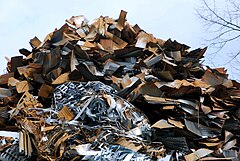 |
|
By S. Müller (Own work) [CC-BY-2.5], via Wikimedia Commons
|
I think one of the best ways to play cellulosic biofuels is to buy the companies which control the cheapest potential feedstocks. I’m not sure that the best use of trash is to make biofuel, but whether it is recycled, composted, digested, incinerated, or converted in to biofuel, I see trash as a future source of revenue in a resource constrained world, and who better to profit from trash than the companies that collect it?
Last summer, I highlighted environmental services companies as a way to invest in biomass in my article Trash Stocks Trashed: An Income Opportunity?
5. Waste Management (WM, $32.71) was my top pick at the time. Since then, the stock has since risen over $2 while continuing to pay its $0.34 quarterly dividend.
6. Veolia Environnement SA (VE, $11.05) was then trading around $16, and I was cautious about the compnay. Today, Veolia seems too cheap to pass up, despite the fact that I expect its 2012 annual dividend to be significantly lower than the $1.47 (13.3%) paid in 2011.
Alternative Transport
 |
| By Steve Morgan (Own work) [CC-BY-SA-3.0 or GFDL], via Wikimedia Commons |
Electric vehicles (EVs) may be cool and appeal to early-adopter techies and some conspicuously consuming greens, but I think EV adoption will be a long, hard slog. The technologies which are likely to advance faster are those that are already economic, but also save transportation fuel. Alternative transportation such as biking, light rail, and buses top my list.
7. Accell Group (ACCEL.AS, €14.15/$18.33) is a Netherlands based bicycle maker which I recently highlighted as a peak oil investment to buy now, because the company has been battered by the EU crisis. Accell is up 11% since then, although the stock still has significant Europe risk.
8. New Flyer Industries (NFYEF.PK $5.6492, NFI.TO) is the largest North American manufacturer of heavy duty transit buses, and currently looks like a steal, despite the fact that the cyclical bus industry is in a downturn, undermining profits.
Both alternative transportation stocks pay healthy dividends, with Accell’s over 6%, and New Flyer’s expected to fall next year to a still healthy 8% to 9% at the current stock price.
Renewable Energy Developers
 |
| Western Wind’s Kingman I Wind & Solar park. Photo courtesy of the company. |
With overcapacity among solar module and wind turbine manufacturers, the consumers solar modules and wind turbines seem best placed to benefit. Low prices are not only good if you are a homeowner looking to put a small PV system on your roof, they are also good for renewable energy developers.
Government subsidies may be cut, but manufacturers still have product to sell, and they’ll continue to do so as long as the price exceeds their marginal cost of production… even if that means they’ll never recoup the capital invested in their factories.
This is good news for renewable project developers who have projects locked in with the current subsidy regime, and who have the financing to build them. The improved economics of owning solar farms can not be more aptly demonstrated by the purchase of a second solar farm by Warren Buffett controlled MidAmerican Energy Holdings.
While selling renewable energy equipment can be an extremely competitive business with constantly eroding margins, power p
roduction is one of the most defensive businesses there is, with electricity usually sold under long term (15-20 years) contracts at pre-determined prices. Nevertheless, small renewable energy power producers are looking cheap compared to their future discounted cash flows.
8. Finavera Wind Energy (FNVRF.PK, $0.409) is a wind project developer in Ireland and British Columbia. Although the company is small, risk is much reduced by joint development agreements with industry heavyweight like GE Energy (GE), which will be providing the equity needed to develop the company’s first 77 MW project in British Columbia, and has indicated interest in additional projects on similar terms. This outside financial muscle is good, since the company’s balance sheet is weak, but the company is working to rectify that: Finavera just closed a $442M private placement at $0.45 a unit (1 share plus half a 12 month $0.55 warrant.)
9. Western Wind Energy Corp (WNDEF.PK, $1.96) just completed its 120 MW Windstar project in time to qualify for the 30% federal cash grant before it expired at the end of 2011. Based just on the company’s completed and advanced projects, I think the discounted cash flow value of Western Wind is now approximately $6, making the company a safe bet with an easy 2-3x upside.
10. Alterra Power Corp. (MGMXF.PK $0.40, AXY.TO), formed by the merger of Magma Energy and Plutonic Power Corp, Alterra has a solid cash position and a diversified base of producing assets across both technologies and geographies. As the company continues to develop projects in-house and bulk up through mergers and acquisitions, I expect the stock price to increase towards the value of its assets, leading to outsize gains for investors who buy at the currently depressed price, which is currently half of book value, and includes $0.10 a share in cash.
Hedge
As discussed above, I think 2012 is a good year to hedge against a broad market decline, and buying puts is the simplest and safest way to do this.
SPY ($125.50) tracks the S&P 500 and has a fairly liquid options. In order to be able to hedge ten stocks with an equal investment in puts, we’ll need to buy significantly out-of-the money puts. For a complete hedge, we’d want the notional value of the underlying shares of SPY to be equal to the value of the hedged portfolio times the portfolio’s beta. Since I don’t put a lot of faith in such calcualtions because betas and other correlations tend to change during market crises, so I’ll just guess and use:
SPY January 2013 $110 Put (SPY130119P00110000, $7.81). For every $781 put contract, the notional value of the underlyng is $11000. If we assume our portfolio’s beta is 1.1, each such put contract would be sufficient to hedge a $10,000 portfolio. The beta of 1.1 is just a guess, but it makes for round numbers. Betas are generally near 1, and are usually higher for riskier stocks.
This hedge not only provides us with some insurance against a large (greater than 13.4% = 1-110/125.5) decline in the S&P 500, it also makes the hedged portfolio greener than the unhedged one. Puts and shorts are effectively dis-investments in the underlying stock or ETF, and to the extent that companies in the S&P 500 index reflect the generally “brown” economy, the hedged portfolio is greener than the unhedged one.
What will 2012 Bring?
I’m optimistic about 2012. Unless we see a total economic meltdown (for which I suggest readers hedge their portfolios, as discussed above), I expect strong appreciation of this portfolio of undervalued clean energy stocks in 2012.
As usual, I’ll track the performance with quarterly updates, with the stock picks benchmarked against PBW.
DISCLOSURE: Long WFIFF, LIME, AMRC, RKWBF, WM, VE, ACCEL, NFYEF, FNVRF, WNDEF, MGMXF, and puts on IWM and SPY.
DISCLAIMER: The information and trades provided here are for informational purposes only and are not a solicitation to buy or sell any of these securities. Investing involves substantial risk and you should evaluate your own risk levels before you make any investment. Past results are not an indication of future performance. Please take the time to read the full disclaimer here.


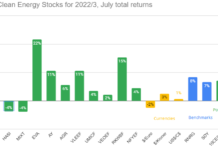

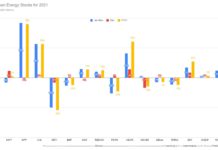
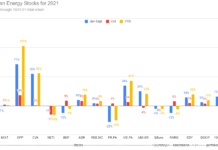
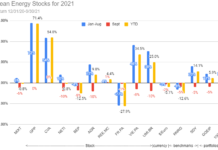


Its an exciting list in exciting times. Many thanks! I only own 5 of the 10 🙁 I’m tempted but I’ve learned from experience not to go out and buy the rest immediately.
HON stands out as a company you haven’t written about in years. Did JCI get consideration at this time?
Is there any significance to the order listed?
No significance on the order- except that I grouped them by sector.
Honeywell was an oversight that I should have written about in my article about Clean Energy Conglomerates. I also considered JCI, but prefer HON because of lower net debt to equity and stronger free cash flow… I think this makes up for the higher P/E.
Note that I don’t currently own either HON or JCI… I’m still waiting for better prices myself, but the list has to go out at the start of the year.
It seems to me that several of these (WFI, LIME, Rockwool, and the power producers) have been hurt by low natural gas prices and would benefit from a natural gas price rise. I believe that will happen and perhaps sooner than people think. Morningstar notes that at current prices a fair amount of natural gas production is uneconomical. I think that environmental damage from fracking is likely and will slow that production.
Makes sense to me, although maybe not Rockwool. Nat gas prices have only really fallen in North America, and Rockwool’s business is mostly in Eastern and Western Europe, although it has a substantial presence in North America.
Second, energy efficiency is typically less price sensitive than other clean technologies. After all, if it were truly price sensitive, we’d have done it already!
Remind me why its less price sensitive? I take it thats not a good thing for the adoption of efficiency technologies. Or more likely its both good and bad but certainly important. . . I think you’ve written about this and I need to look for that article.
Why is energy efficiency less price sensitive? It’s almost tautological. If we were price sensitive when it comes to energy, we’d do everything we can which would save use money. Energy efficiency measures are things which we have not yet done which could save us money… so we must not be price sensitive with regards to those measures.
In economic terms, if it were an efficient market, the energy efficiency opportunity would not exist.
Why does it exist? http://www.altenergystocks.com/archives/2007/08/why_energy_efficiency_is_a_hard_sell_2.html
Great article, that link from 2007.
Regarding WFIFF, I assume you plan to hold for the long term but do you have a fair value estimate in mind for the business as it stands right now?
No, I don’t have an estimate of WFIFF’s current value. I only do fair value estimates when future income streams are clearly defined, as was the case with WNDEF. For companies like WFIFF, it’s more a judgement call that the market is too pessimistic about the company.
New Flyer spoke to the media about their electric bus project: http://tinyurl.com/7mxbo6u
No real new information but its encouraging to see the excitement of the engineer and be reminded that the Province of Manitoba is strongly supporting this project.
A bullish trend for New Flyer: Transit patterns are changing. Younger folks prefer to ride!
http://tinyurl.com/79uzubb
New Flyer makes a cryptic announcement on Feb 3: it is holding discussions with a third party regarding a potential commercial and strategic relationship. Perhaps this explains this week’s rise in the stock. Are we to assume this is a good thing for the company?
You said it yourself, it’s cryptic. Clearly most investors are assuming it’s good.
But really, such discussions can’t be bad unless management is incompetent or not doing their duty. If a relationship were bad, why enter into it?
We can also assume that this is a very significant potential relationship as well. IF it were minor, they would feel no need to preannounce it.
Makes sense! I hope this doesn’t turn out to be a non-story in the end–or evidence that they are not dealing from a position of strength.
Hi Tom,
I’ve recently become interested in implementing the hedging strategies you describe in your annual portfolios.
You mentioned that a hedge on the “brown” economy makes your portfolio greener in addition to insuring against a decline in the broader market – so does this addition of a position mean you are doubling down on green? You mentioned that you are confident a decline in your portfolio would be matched with a decline in IWM – how would you describe the increased or reduced risk/reward of your portfolio?
I’d also be interested in an update on your article on http://www.altenergystocks.com/archives/2009/09/hedging.html – have your opinions changed? like you mention, hedging seems like a good idea given the fragile economy and political situation
Okay, the article deserves an update, especially since I now have moved to almost the exclusive use of puts for hedging, rather than shorts, short calls, or short call spreads.
Is it doubling down on green? Not really, it’s more like changing your bet from “green will do well” to “green will do better than brown”